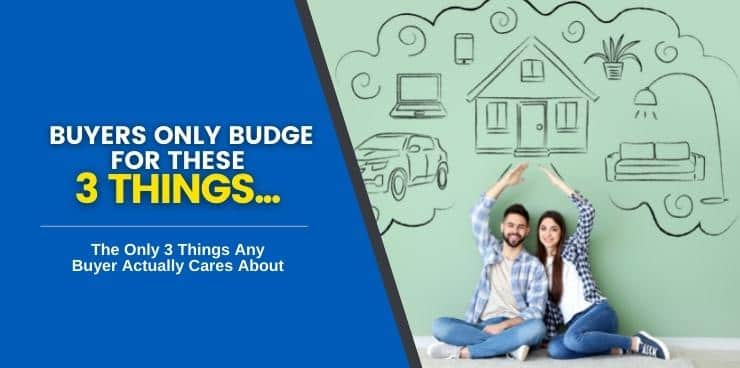
Do buyers have buying motivation when looking for a grudge purchase, like a new air conditioning system?
The answer is yes.
More than anything else, buying motives are based on a person’s perceived desires and emotional motives. When making any purchase, people are driven by what they believe they want (often superficially) and how that purchase makes them feel (often subconsciously). These are the underlying felt needs. Buyers are looking to reduce stress, anxiety, and frustration and gain calm, happiness, and balance. Felt needs are the only 3 things a buyer cares about once the decision has been made to take action on a purchase.
But there is something steering the buyer to start weighing out their felt needs, and that’s a list of motives, both positive and negative, that are dictating what actually matters if this purchase is to take place. All of this is going on in their head without them ever realizing it. Unconsciously, they are using a customer motivations list to make their decision.
Buying motives are instigated by the prospect’s current mindset based on their current situation and station in life. Some buyers are in Thriving Mode, while others are in Survival Mode. Their mode will determine whether they are motivated by the antimotivators of fear, shame, and guilt that live in Survival Mode, or the motivators of identity, purpose, and adventure that live in Thriving Mode.
All buying motives play a role in the buyer’s journey. It starts with awareness, moves on to interest, then decision, and if you’ve done your job well, action to buy with you. Here’s how it all comes together:
- Awareness: The first stage is when a prospect becomes aware of you in relation to potential problems you solve. Done correctly, they won’t need what you sell at that moment in time, but you’ve officially popped up on their radar. However, they are now aware that you exist and could potentially meet their underlying felt needs.
- Interest: Getting someone’s attention is easy. Keeping it is far more difficult. When you entertain, edutainment, and endear yourself further with your potential buyers, they will step into your gravity well willingly. They learn about your products or services that could meet their needs and file you away as a contender for when they need your thing. Customers compare different options and start to narrow down their choices. At this stage, they are still undecided about which product or service to buy, but there is no real urgency to make a decision.
- Decision: In residential home services, something happens in the potential customer’s life and they are forced to make a decision on who to buy from. Most often, they have considered all their options superficially and decided on you if they know, like, and trust you the most at their time of need.
- Action: Action is the step your prospect takes to book an appointment. That means they actually pick up the phone or schedule an appointment on your website.
Buyer tips:
- You will also want to make sure you know your buyer persona well. It will help you understand what kind of content they are likely to be interested in and how best to reach them.
- Some customers have joint decision makers or decision influencers. These people help make the final decision but are not the main point of contact for the sale. It is pertinent to satisfy their felt needs too since they will be influential in the decision-making process.
- Buyer’s remorse happens to some customers after making a purchase. They regret their decision and wish they had chosen a different product or service, or to do nothing at all. Avoiding buyer’s remorse means ensuring your customer is happy with their purchase. You want them to feel like they made the best decision possible by reinforcing that it fulfills their actual felt needs.
In the end, it’s up to the customer to decide which product or service to buy. You can help them, though, by providing information and guidance along the way.
Speaking of guidance…
Read the rest of this article to learn the only three things any buyer actually cares about.
The Development of a Framework
When you finally figure out what people actually need based on their list of wants and desires, it’s worth having a framework to get to what matters. This will increase your persuasiveness when it comes time to interact with your prospect.
One of the earliest attempts was by Hippocrates. The Greek physician believed 4 Humors determined a person’s personality: Blood, black bile, yellow bile, and phlegm.
Myers-Briggs is another popular personality assessment in use today. It’s based on the work of Carl Jung and divides people into 16 different personality types.
Then there’s DiSC, which is used extensively in business. It focuses on four different behavior styles:
- Dominant: People who are results-oriented and like to take charge.
- Influential: People who are good at persuasion and motivation.
- Steady: People who are calm and consistent.
- Conscientious: People who pay attention to detail and follow the rules.
Kolbe is yet another well-known system that measures four different areas:
- Factfinder: How you collect information.
- Follow through: How you work with the information collected.
- Quick start: How you initiate projects.
- Implementor: How you complete projects.
And last but not least are archetypes and buying motives. Carl Jung’s work on archetypes is particularly interesting. Understanding buying motives is crucial, too, because they can help you create more effective marketing messages.
The point of learning about personality types is to gain knowledge of yourself and others. It is particularly true in sales and marketing. Understanding the different personality types can create more targeted and effective marketing messages. Knowing your personality type can help you learn how to be a more effective persuader.

THE 3 CORE FELT NEEDS: The Only Things Buyers Actually Care About
Always remember that your end customers are real people. Your client’s satisfaction is not a function of how much they like your product. It is entirely dependent on whether their needs are met.
The key to delivering an exceptional customer experience is understanding what customers care about most and then making sure you deliver on those fronts. Knowing where a buyer is coming from is the secret sauce for success when it comes to sales and marketing. It’s where every buyer actually comes from.
A transactional shopper in survival mode is most concerned about money, then energy, then time. A relational buyer in thriving mode is prioritizing their time first, followed by energy, then money last.
Think of energy as the ends, with money and time being the means. People are in constant pursuit of getting to or exceeding a baseline of positive energy. Sometimes called happiness. Sometimes called peace, balance, calm, or safety.
Your job is to show them how your solution gets them to that state of balance. When your solution meets or exceeds their personal money, energy, time output, you’ve demonstrated value that meets or exceeds their investment. That’s when you make the sale.
A loyal customer base occurs when you exceed the minimum baseline. This is when they perceive your value is greater than their cost of doing business with you. Always put customer satisfaction first. It’s not always easy to please everyone, but figuring out if they’re a transactional shopper or a relational buyer is vital to your persuasion.
Never underestimate the importance of customer service. Good customer service is the key to success in any business. It can make the difference between a satisfied customer and an unhappy one.
Your customers just want to be happy. They don’t want to deal with pain points like incompetent people, limited selection, salesy slicksters, slow service, warranty, refunds, or avoidable aftercare. That’s why ensuring your business provides the best possible buyer experience for them at each touchpoint and post sale is essential.
Your customers are motivated by pleasure points and negatively motivated by antimotivators. When you reconcile them better than your competitors, they’ll keep coming back to you. They’ll also tell their friends about you and write 5-star reviews.
Many factors contribute to good customer service. One of the most important is understanding the buying motives of your customers.
Ask yourself: What and why do they want it, and how can I give it to them? How can I create client loyalty?
The answer lies with the 3 CORE Felt Needs: Money, Energy, and Time (MET).
 Money
Money
Ask yourself: What’s their perceived ROI?
To create loyalty, you need to give your customers a good reason to return. That means giving them something worth more than their investment. If you can build a viable case that includes their most obvious form of measure, money, in conjunction with the other 2 costs (time and energy), you have a better value proposition than your competitors. It sounds simple enough, but it’s not always easy.
Energy
Ask yourself: How am I removing all forms of stress?
The human body was designed for stress. It’s the basis for our survival. When you can offload any and all forms of stress, making it easy for them to get back to normal, or better, you get the sale. Customers want to be able to get what they need without jumping through hoops.
Whether a person values their time or money more, they are ultimately in a constant pursuit of (positive) energy. -Ryan Chute
Time
Ask yourself: How can I save them time?
The best businesses are the ones that anticipate their customers’ needs before they even know they have them. Angst often comes from the pressure we put on our time. We know how little time we have. We know what we lose by not wanting to allocate our time to externally triggered grudge purchases. For those who cherish the little time they have, the companies that win are the ones who take on anything that burdens their time. Anticipating your buyers needs and resolving them is job one.
The Amygdala: Our Uncontrollable Lizard Brain
The amygdala processes our environment 5 times every second. It is making a threat assessment for risks and rewards constantly and distributing chemicals instantaneously in an effort to survive and thrive.
These chemicals are dispensed according to the perceived threat or opportunity. Larger doses can create an adhesive (like glue) to our memories. These memories can play a role in decision-making as things stick with us.
People who have a positive experience with your brand may remember it. With more positive impressions, the more real estate your brand takes up in their mind. Done well, you can create a positive feedback loop. This is the biology of customer loyalty.
Conversely, people who have negative experiences are equally likely to remember them. The more extreme (or traumatizing) the experience, the more chemicals are produced, increasing the likelihood of memory stickiness. This forms a negative feedback loop. These are the fundamentals of PTSD. The customer is less likely to repeat an experience with you and may tell others to avoid your business too.
It’s crucial to keep this in mind when you’re designing your customers’ experience. From your ads to the way you answer the phones, from the sales experience to the aftercare, every touchpoint matters.
Remember, people pursue pleasure and rewards in their brains. They will do a lot to avoid stress, frustration, anxiety, risk, punishment, and pain. As a business, you should strive to manifest a positive experience that meets or exceeds their minimum baseline of happiness (positive resonance).
Make sure your employees are properly trained to deal with customers. Empower them to make decisions that will create a positive experience for the customer. Most importantly, listen to feedback so you can learn from your mistakes and continue to improve the customer experience.
The bottom line is that happy customers are good for business. Do what you can to ensure they have a positive experience while interacting with your company. It’ll pay off dividends in the long run.
 Buying Motives: Read Between The Lines
Buying Motives: Read Between The Lines
To understand your customer’s buying motives you need to ascertain from which angle they are pursuing happiness. Transactional shoppers are starting at price and relational buyers are starting at time.
So, what are their underlying felt needs?
Give them what they want. It’s essential.
The first step to understanding your customer’s buying motives is to pay attention to what they say. They will not be forthcoming with their true feelings because felt needs are more subconscious. They’ll be masked by what the buyer says they want and desire. Listen closely, read between the lines, and you will get an idea of where they’re coming from. Look for clues in the way they talk about their problem.
What words do they use? What position do they take? Are they protecting their time? Are they hoarding resources, or simply protecting them against the unknown. The answers to these questions will give insight into how your customers feel and what they really need.
Money, energy, and time are the test you have to pass to win the sale.
-Ryan Chute
Once you understand your prospect, you can begin to craft the most persuasive pitch. Keep it focused on their prominent need and demonstrate what you can do for them. The bottom line: Always put the customer first. Show them that you understand their needs and provide a solution, and you’ll make the sale.
One more time, ask yourself: What does the customer need?
The simple answer:
To be happy.
Keep your sales message customer-centric, and you’ll close more deals.
One last question: Do I have the tools to strategize my customers’ satisfaction?
If your answer is anything other than yes, Ryan Chute, Wizard of Sales® would like to talk. Book a call.
- Futuristic Game for the Ad Masters - July 11, 2024
- Classical Conditioning: Pavlov’s Dog in Advertising - June 20, 2024
- Hear, See, Speak No Advertising - June 9, 2024
